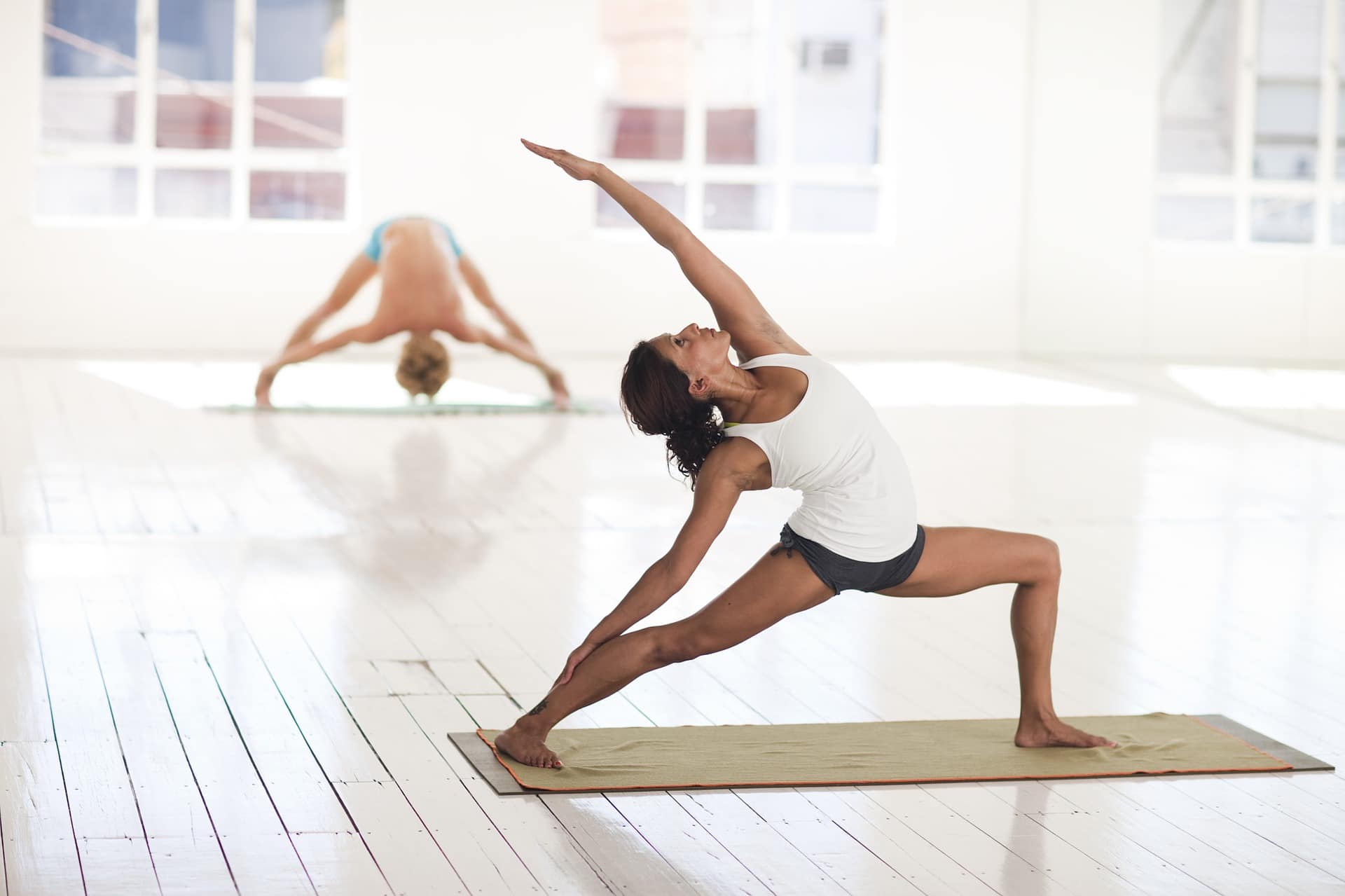Even if you don’t do yoga, you likely know someone who does. The numbers don’t lie. Yoga has been around since the dawn of civilization, and the most recent yoga statistics show that it isn’t going to disappear anytime soon.
2020 completely disrupted society as we knew it, bringing a lot of stress, anxiety, and uncertainty into our already hectic lives. Confined in their homes, many people started exploring methods that helped them get through these times and remain healthy. Somehow, yoga seems to be on every list of stress-reducing techniques on the internet.
If you’ve already done your reading, you know that yoga reduces stress levels, helps with chronic pain and injuries, and stabilizes blood pressure. But if you haven’t, take a deep breath and scroll down, because that’s just some of what you’ll learn in this article.
The Top 10 Yoga Facts and Stats
- There are 300 million yogis worldwide.
- Yoga is over five millennia old.
- The yoga industry is worth $37.46 billion.
- 67% of yoga practitioners prefer to do yoga in their homes.
- Yoga has been on UNESCO’s list of world heritage since 2016.
- Practicing yoga decreases blood pressure by 3.8 mmHg.
- Yoga relieves chronic pain in 89% of patients.
- 8.7% of Americans are yoga practitioners.
- Yoga has an injury rate of over 10%.
- 72% of yoga practitioners are women.
Facts About Yoga to Get You Started
1. Yoga is over five millennia old.
(YogaBasics, Britannica)
The ancient forms of what we today know as yoga originally developed in Northern India. It was first mentioned under this name in the Rigveda, a collection from 1500 BCE containing 1,028 poems discussing sacred rituals and mantras for priests to use.
2. Yoga has been on UNESCO’s world heritage list since 2016.
(The Guardian)
In December 2016, UNESCO confirmed that yoga had a place on its list of intangible forms of world heritage, honoring Indian culture’s impact on the lives and health of individuals worldwide.
3. There are 13 basic types of yoga.
(YogaMedicine)
One of the interesting facts about yoga suggests that, since its beginnings, yoga has developed to include its practitioners’ different needs and goals worldwide. The basic forms of yoga are Acro Yoga, Aerial Yoga, Ashtanga Yoga, Bikram Yoga, Hatha Yoga, Iyengar Yoga, Kundalini Yoga, Prenatal Yoga, Power Yoga, Restorative Yoga, Sivananda Yoga, Vinyasa Yoga, and Yin Yoga.
4. The oldest active yoga teacher died at the age of 101.
(Today)
The Guinness World Record for the oldest active yoga teacher is officially held by Tao Porchon-Lynch, who started practicing yoga at age eight.
5. The oldest known yoga teacher lived to be 102.
(Oldest)
Unofficially, the world’s oldest known yogi was Indra Devi, who died in 2002. Indra, born as Eugenie Peterson in Russia, is regarded as the “mother of Western yoga” and the first non-Indian yoga instructor.
Worldwide Yoga Statistics
6. There are 300 million yogis worldwide.
(CompareCamp, Leger)
Recent data show that around 300 million people engage in yoga worldwide. However, it’s worth knowing that over 100,000 yogis are from India. Not counting India, yoga statistics in Canada place this country at the top, with 21% of its citizens being active yoga practitioners.
7. The yoga industry was worth $37.46 billion in 2019.
(Yahoo Finance)
The latest reports on yoga industry statistics showed that coronavirus lockdowns led to an increase in the number of practitioners, and the industry is expected to reach $66.22 billion by 2027.
8. Approximately 20% of yogis are willing to try laughter yoga.
(Eventbrite)
Yoga statistics worldwide have shown that yoga keeps changing due to its increasing popularity and number of practitioners. The market offers classes of naked yoga, beer yoga, and even silent disco yoga for those willing to experiment.
However, if you don’t want to experiment as much, you aren’t alone: 39% of people would like their yoga classes to include massages, and 21% would incorporate spa treatments or dance lessons.
9. 8.7% of Americans are yoga practitioners.
(YogaU)
That totals 20.4 million people, 82.2% of them being women. Yoga statistics in America point out that Americans spend over $10.3 billion annually on yoga classes and equipment (like mats and clothing).
Analyzing prevalent practices in the yoga population, statistics note that 38.4% of practitioners in America are people who’ve been doing so for less than a year. Only 15.6% describe themselves as experienced yogis. Most practitioners (62.8%) are between 18 and 44 years old and motivated by their wish to improve their agility (78%).
10. Yoga first came to America in the late 1800s.
(YogaBasics)
When it comes to yoga history, the facts confirm that it first appeared in the US in 1893, when yogi Swami Vivekananda held a lecture at the Parliament of Religions in Chicago. Its expansion was relatively slow until 1947, when Indra Devi started a yoga studio in Hollywood.
11. As much as 67% of yoga practitioners like to do yoga in their homes.
(Eventbrite)
While this trend has come in handy with the recent lockdowns, trends suggest that only 43% and 38% of practitioners like to do it in a gym or a yoga studio, respectively. One of the interesting facts about yoga is that doing yoga outdoors is the preferred choice of only 32% of yogis.
12. Yoga has an injury rate of over 10%.
(Science Daily)
Although it looks like a very calm and safe activity, yoga injury statistics indicate that its practitioners experience pain comparable to other sports. Even more surprising is that yoga can worsen existing conditions and injuries, as 21% of people reported that their symptoms felt exacerbated after doing yoga. Injuries obtained during yoga can be severe enough to prevent people from engaging in physical activity for over three months.
13. Of all yoga practitioners, 72% are women.
(CompareCamp)
Despite a 150% increase in the male population among yoga practitioners in recent years, women still represent the majority. When it comes to age, 43% are people between 30 and 49 years old.
14. In the case of yoga in the workplace, statistics indicate a rising trend.
(Forbes)
A 2018 survey conducted by the National Business Group on Health (NBGH) included 163 companies and found that 52% of them have some kind of training aimed at employee stress release or mindfulness. The most frequent (and the most cost-effective) offers included yoga or meditation.
15. The biggest yoga lesson gathered 100,984 attendees.
(Guinness)
It comes as no surprise that the largest yoga lesson was held in India, in the State of Rajasthan in 2018. It was organized in the open and gathered 100,984 people.
Yoga Health Statistics
16. Yoga relieves chronic pain in 89% of patients.
(Science Daily)
When it comes to yoga statistics from 2020, a survey published by the American Osteopathic Association found that practicing yoga positively affects patients who deal with chronic pain. This condition affects almost 100 million patients in America, and the research shows that yoga helped many of them increase their functionality, mood, and overall perception of pain.
17. Approximately 54% of people start yoga to release tension.
(Eventbrite)
Global yoga statistics also demonstrate the different reasons people practice yoga. Improving physical and mental health comes right after releasing tension, with 52%. Other reasons include distancing from technology (20%), preventing loneliness (21%), and self-care (27%).
18. Yoga decreases depressive symptoms across all 17 Hamilton Depression Rating Scale items.
(SAGE, National Center for Biotechnology Information)
Several recent studies have shown that practicing yoga has a positive effect on patients with depression after only two months. Looking into these facts about yoga, the benefits include an overall decrease in symptoms. This was reported even in patients who didn’t respond to classical treatments with different antidepressants. It’s believed to be the result of cortisol reduction—i.e., lowering the so-called stress hormone during yoga.
19. Yoga practitioners can lose an average of 3.5 kg (7.7 lbs) in three months.
(National Institutes of Health)
A pilot study conducted in 2019 showed that yoga provides significant support to patients following a diet. The patients were asked to do three sessions of yoga a week for three months. Even better, the lost weight increases to 5.6 kg (12.3 lbs) after an additional three months.
20. Yoga significantly increases endorphin levels in your body.
(National Institutes of Health)
Yoga statistics have shown that adopting yoga as a part of your everyday exercise routine has been proven to increase longevity and affect the cellular biomarkers that influence aging. This is achieved by releasing stress, which has a deteriorating effect on an individual’s overall health.
21. Yoga improves spinal bone mineral density by 0.0029 g/cm2 a month.
(National Center for Biotechnology Information)
In the period between 2005 and 2015, a team of researchers conducted a study that included 741 people to examine yoga’s effects on bone density. Participants used different weight-bearing poses believed to stimulate bone health. They showed signs of overall bone quality improvement, greater bone density in the spine, and even a reversal of bone loss.
Further yoga facts indicate that stretching and twisting muscles during yoga stimulates internal organs, improving overall well-being and providing support for other processes in the body.
22. Practicing yoga decreases blood pressure by 3.8 mmHg.
(National Institutes of Health)
Even more positive yoga statistics and facts show that doing 90 minutes of yoga per week can significantly lower your blood pressure after just twelve weeks. A 2018 trial included patients with arterial hypertension who were split into two groups. In this period, the patients who did yoga measured a significant decline in both systolic and diastolic blood pressure compared to the patients who continued their treatment unchanged.
Bottom Line
We hope that at least some of these yoga statistics were enough to get you thinking. After all, among the many different types of yoga, there must be one that will appeal to you.
Taking care of your mental and physical well-being seems crucial when navigating your way through a global pandemic. So reread our list of yoga facts and stats and give it a try—there’s nothing to lose.
FAQ
What percentage of people do yoga?
Over 300 million people practice yoga worldwide, and according to yoga statistics, India contains the majority. Apart from India, 21% of Canada’s population practices yoga, making it quite popular. Estimates for the US show that 8.7% of American citizens do yoga regularly.
(CompareCamp, Leger, YogaU)
Do yoga practitioners live longer?
Research has shown that yoga increases both the mental and physical health of its practitioners. While there’s no exact data that yoga increases life expectancy, there’s proof of its effect on the aging process and how it increases the chance of a good and healthy life.
(National Institutes of Health)
Where is yoga most popular?
Yoga statistics show that yoga is the most popular in its place of origin: India. It’s estimated that close to half of yoga practitioners worldwide are Indian. In fact, in 2018, India hosted the largest-ever yoga class, gathering 100,984 yogis in total.
(CompareCamp, Guinness)
Sources:
- Britannica
- CompareCamp
- Eventbrite
- Forbes
- Guinness
- Leger
- National Center for Biotechnology Information
- National Center for Biotechnology Information
- National Institutes of Health
- National Institutes of Health
- National Institutes of Health
- Oldest
- SAGE: Bridges, Sharma, 2017
- Science Daily
- Science Daily
- Today
- The Guardian
- Yahoo Finance
- YogaBasics
- YogaMedicine
- YogaU













